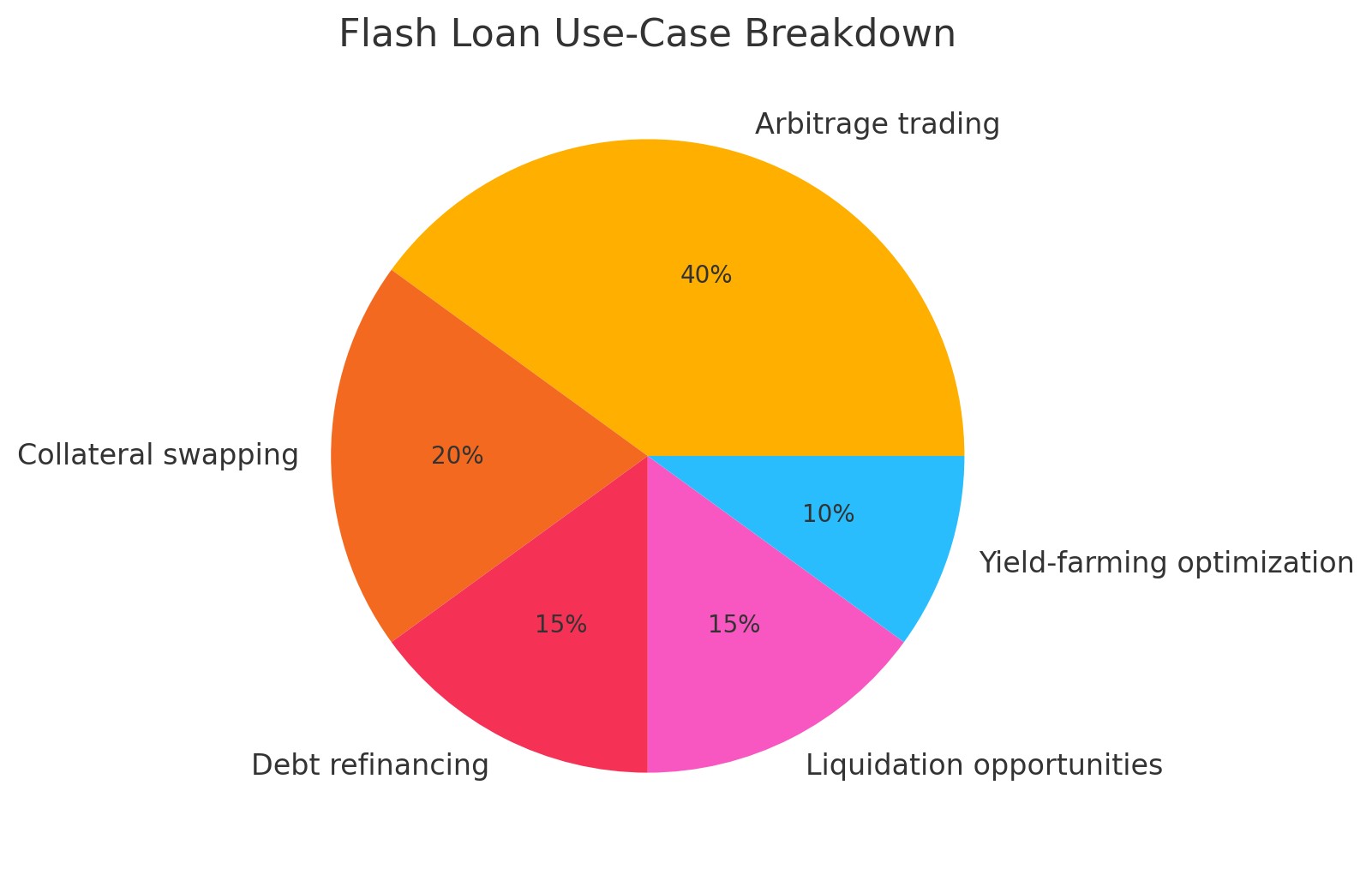Flash loans have rewritten the DeFi rulebook in a big way. They let people borrow money, negating the need to put anything up front, and they are paid back in the same operation. They play a key role in DeFi, opening up instant trading, quick profit chances, and more.
This article dives into how flash loans work, where they’re used, and the benefits and dangers they pose. It also looks ahead, sharing what could come next based on careful research so that you see the whole picture.
Flash Loans’ Inner Workings
These are a novel kind of DeFI tool. They provide individuals the means to borrow big without putting up any security to back it, presuming the loan is repaid within that same operation.
Supposing that doesn’t happen, the whole undertaking cancels itself, so the lender isn’t affected in any way. This is rendered possible by smart contracts and the mechanisms blockchains conduct transactions through.
People mostly use flash loans to achieve such ends as:
- Arbitrage exchanges
- Swapping collateral
- Reorganizing debt payments
- Liquidator endeavors

Since the money is borrowed and returned almost instantly, there’s no need for upfront capital. This type of loan doesn’t exist in traditional banking. It depends entirely on how blockchains like Ethereum are built to run all steps in a transaction, together or not at all.
The process works by packing several actions into a single transaction. For example, It lets someone borrow money during one block of time, as long as it’s paid back, plus a small fee, before the block ends. Should anything head south, the system just rolls it back again. That way, the lender is always safe.
As the basis, the borrower writes a particular contract. This agreement submits a request for the loan, directs the money to achieve whatever stipulated tasks, and then pays it back right away. The steps might involve swapping assets, paying debts, or shifting funds around. But everything has to finish in one go.

Since the blockchain sees all of this as a single move, the loan acts like free short-term money – useful for complex trades, so long as there’s enough liquidity in the pool and room in the transaction.
Flash Loans vs. Traditional Lending
Flash loans shake up the usual rules of crypto lending. In traditional DeFi lending, you lock up something valuable, like ETH or a stablecoin, so you can borrow against it. If the market turns, you might lose your deposit. Flash loans flip that idea. You don’t need any deposit up front, but you must pay back the loan plus a fee right away.
If you can’t, the whole deal just never happened. This makes it impossible to fail, since the blockchain undoes everything when repayment doesn’t happen. The lender’s money is safe in a single transaction, so there’s no risk of default.
This new way of borrowing changes how people use on-chain money. Anyone who can write a valid transaction can tap big sums without checks or deposits. Borrowing and trading blend into one action instead of two separate steps. You borrow large amounts in a single block of time to do things like tossing funds amidst protocols or arbitraging.
Flash loans let any developer act like a market maker or liquidator. They open up fast moves that were once only for top traders, so that complex strategies happen in seconds instead of minutes.
DeFI crowdlending is another alternative where investors can all chip into multiple loans while sharing the risk. These offer a great profit opportunity. Some companies, like 8lends, offer lending with borrower collateral to secure their investments, not to mention zero commissions to investors.


Benefits of Flash Loans
The notable benefits of flash loans to the DeFi ecosystem include:
- Instantaneous availability of major credit: No advance collateral is imposed. Thus novices and smaller players alike open up opportunities for big-time, complex operations. The Bank of Canada says flash loans widen on-chain liquidity; therefore, advanced DeFi tactics open up to more people.
- Better market efficiency: Flash-loan arbitrage narrows price disparities among exchanges. When tokens are mispriced, these loans jump in and adjust matters quickly. Traders experience steadier, more uniform prices.
- Zero default risk for lenders: Lenders assume no potential negative consequences. The loan must be repaid in the same transaction, or it never happened. Flash loans are therefore rendered cheaper and more pliable, leaving players little to be anxious about as opposed to older-style lending.
- Expanding, new DeFi blocks: Flash credit sparks new DeFi products. Developers can string together steps amidst multiple protocols to enter a leveraged holding or assemble yields without advance capital. Experts call them an exciting new financial primitive unique to DeFi.
Risks and Attack Vectors

Flash loans bring big risks. They let bad actors tap huge sums right away. That can expose protocol bugs or let someone push prices around.
- Price oracle manipulation: Many DeFi apps use on-chain price feeds, like a DEX rate, to value collateral. An attacker can borrow a mountain of Token A and swap it on a decentralized platform to augment its price. This inflated value is subsequently utilized as as collateral to borrow other tokens, drain the pool, return the flash loan, and keep the profit. Relying on a single DEX feed makes this trick all too easy.
- Exploiting smart contract errors: Flash loans exacerbate existing bugs. In 2020, bZx was squeezed about $620,000 when someone borrowed 10,000 ETH via a flash loan and hit a pricing bug. A small logic error led to massive losses because the attacker could move so much capital in one go.
- Attacks on complex protocols: Even well-audited systems can fall. In 2023, the Platypus stablecoin AMM on Avalanche was hit twice. One attack in February cost roughly $8.5 million; another in October cost about $2 million. Each time, attackers used flash loans to fool internal checks and drain liquidity before patches took effect.
Flash loans let attackers take swings at no upfront cost. If the exploit fails or stalls, they walk away without losing a cent. That turns complex hacks into risk-free gambles. Flash loans don’t cause bugs. Instead, they reveal and worsen existing weaknesses. To fight these threats, many protocols now use stronger oracle networks so as to lock down price data and run intense security audits. Still, the wave of flash-loan attacks in 2023–2025 is a warning: any new DeFi app must be built to resist them.
Flash Loan Adoption and Trends

Flash loans started as a curious DeFi novelty – now they’re a basic tool in finance. Since about 2018, their use has grown fast. Loans reached over $2 trillion in on-chain lending in 2024 alone, spread across some 10 million transactions. That works out to hundreds of millions of dollars in flash loans every day.
Growth comes from better DeFi networks. More than a dozen lending sites now let users tap flash loans, and even blockchains beyond Ethereum are copying the idea. In 2024 and 2025, big names jumped in. Aave released V4 with more flash loan features, and Compound is adding its own version through EIP-3156.
Most flash loans run on Ethereum. Yet Arbitrum, Avalanche, Polygon, and others see plenty of action too. This spread lets users pick networks with low fees or deeper pools. Use is changing so that flash loans fuel bots for liquidations and portfolio moves, not just simple arbitrage.

However, easy cash on demand comes with risks. Many hacks in 2024 and early 2025 leaned on flash loans. Attackers moved tens of millions of dollars in minutes. These events drive the need for stronger security checks as well as insurance in DeFi.
Conclusion
Flash loans have changed the way the rulebook is written. For developers and participants, this ushers in a realm of new pathways. There are those use flash loans for quick exchanges while also people who move around assets and readjust finances on the fly. These actions help bring together dispersed pools of cash, which improves how smoothly the market runs.
If crowdlending resembles an endeavor you’d be interested in, it is easy as can be to get involved. The risk has been optimized to suit your exact appetite in that field as well.








